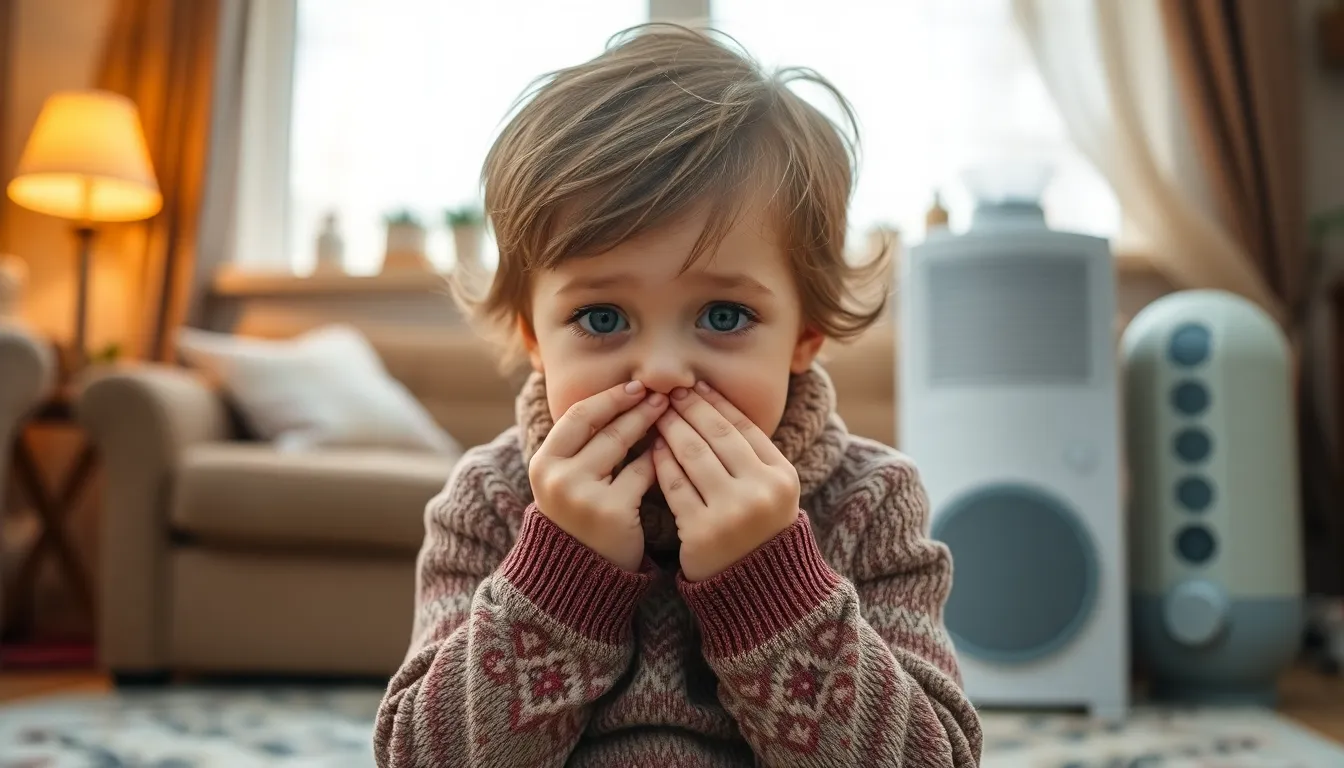Nosebleeds in children can feel like a scene straight out of a slapstick comedy—one moment they’re laughing, and the next, they’re sporting a crimson souvenir. While it might seem alarming, these little episodes are often more common than you’d think. Understanding what causes these spontaneous fountains can help parents tackle the situation with confidence instead of panic.
From dry air to boisterous nose-picking, several culprits can be behind those unexpected drips. Kids are naturally curious and adventurous, which sometimes leads to a bit of mischief that can result in a nosebleed. By pinpointing the causes, parents can take proactive steps to reduce the frequency and keep their little ones laughing—without the need for a tissue box on standby.
Table of Contents
ToggleOverview of Nose Bleeding in Children
Nose bleeding, also known as epistaxis, occurs frequently in children and warrants attention from parents. Dry air acts as a common culprit, particularly in winter months when indoor heating lowers humidity levels, leading to dryness in nasal passages. Children often engage in nose-picking, aggravating the delicate blood vessels lining the nostrils. Allergies cause inflammation and irritation, which may also contribute to nosebleeds in sensitive children.
Frequent upper respiratory infections create inflammation, making nasal tissues more prone to damage. Injury from falls or rough play can also result in trauma to the nose, causing bleeding. Certain medications, particularly anticoagulants, increase blood thinning, raising the risk of bleeding episodes. Structural abnormalities, such as a deviated septum, can predispose children to recurrent nosebleeds.
To minimize the occurrence of nosebleeds, maintaining a humid environment proves beneficial. Using saline nasal sprays or applying a thin layer of petroleum jelly inside the nostrils helps keep the nasal passages moist. Avoiding harsh environmental factors, such as smoke or strong odors, greatly aids in reducing irritation.
In most cases, nosebleeds pose little danger. Parents should remain calm, assess the situation, and manage the bleeding effectively by having the child sit upright and lean slightly forward. These simple actions can reduce the risk of swallowing blood, which can cause nausea and anxiety.
Common Causes of Nose Bleeding

Nosebleeds in children often arise from various environmental and health-related factors. Understanding these causes helps parents address situations effectively.
Environmental Factors
Dry air commonly triggers nosebleeds, especially during winter when indoor heating worsens the dryness in nasal passages. Humidity levels decline, leading to irritation and cracking of delicate tissues. Frequent exposure to allergens like dust, pollen, or pet dander often contributes to inflammation, making blood vessels more prone to bleeding. Additionally, smoke from cigarettes or fireplaces can irritate sensitive nasal membranes. Children engaging in vigorous activities may accidentally injure their noses, further increasing the risk of bleeding.
Health Conditions
Certain health conditions like allergies or respiratory infections significantly raise the likelihood of nosebleeds. Allergies provoke inflammation and lead to frequent nose-blowing or rubbing, which aggravates blood vessels. Chronic sinusitis and upper respiratory infections make nasal tissues more vulnerable and susceptible to bleeding. Blood disorders, although rare, can also cause frequent nosebleeds due to thinning blood. Moreover, medications that affect clotting may increase the severity or occurrence of nosebleeds.
Risk Factors for Nose Bleeding
Several factors can increase the likelihood of nosebleeds in children. Understanding these risks helps parents manage and prevent episodes effectively.
Age and Development
Younger children are more prone to nosebleeds due to their developing nasal structures. Nasal passages in children are generally smaller and contain more delicate blood vessels. Increased activity levels often lead to falls or trauma, further heightening the risk. Boys typically experience nosebleeds more frequently than girls. Age-related behaviors, such as nose-picking, also contribute to higher occurrences. Alongside growth, the frequency of nosebleeds tends to decrease as children mature.
Seasonal Changes
Seasonal changes greatly influence the frequency of nosebleeds in children. Dry air during winter months irritates nasal membranes, making bleeding more likely. Indoor heating exacerbates low humidity, leading to dryness in nasal passages. Spring and fall may see increased nosebleeds due to allergies from pollen and other environmental allergens. Rainy seasons or humidity can provide relief, yet rapid temperature changes may trigger irritation. Monitoring indoor humidity levels can help mitigate these effects.
Prevention Strategies
Effective prevention strategies can significantly reduce the occurrence of nosebleeds in children. Various home remedies and proactive measures can help maintain nasal health, ultimately leading to fewer episodes.
Home Remedies
Using a humidifier in children’s rooms helps maintain moisture in the air, which keeps nasal passages hydrated. Incorporating saline nasal sprays regularly can soothe irritated tissues and prevent dryness. Applying a small amount of petroleum jelly inside the nostrils often creates a protective barrier against irritation caused by dry air. Encouraging gentle nose blowing instead of picking helps protect delicate blood vessels. Lastly, ensuring that children remain well-hydrated contributes to overall nasal health.
When to Seek Medical Attention
While most nosebleeds in children aren’t serious, certain situations warrant medical attention. If a child experiences frequent or unusually heavy nosebleeds, consulting a healthcare professional is crucial. Blood that doesn’t stop after 20 minutes of applying pressure indicates a need for evaluation. Additionally, any nosebleeds accompanied by unusual symptoms such as bruising, fatigue, or paleness merit immediate medical consultation. If a child sustained a head injury before the bleeding, seeking professional help should occur promptly to rule out any serious complications.
Nosebleeds in children are a common concern for many parents but understanding their causes can alleviate anxiety. By recognizing factors like dry air, allergies, and minor injuries, parents can take proactive steps to reduce occurrences. Implementing simple prevention strategies such as using humidifiers and saline sprays can make a significant difference.
It’s essential for parents to stay calm and manage nosebleeds effectively when they occur. Knowing when to seek medical attention is crucial if nosebleeds become frequent or severe. With proper care and awareness, children can continue to enjoy their activities without the worry of nosebleeds interrupting their play.





